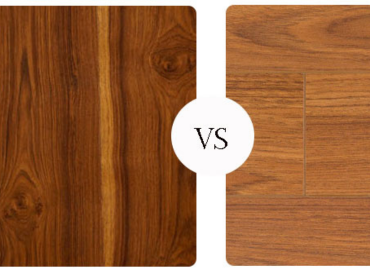Choosing between wooden tiles and laminate flooring can be tricky. Both have their strengths, but which one is best for your space? In this guide, we’ll explore the differences, their pros and cons, and help you make an informed decision for your home or office.
Wooden Tiles vs. Laminate Flooring: Key Differences and Pros/Cons
When it comes to flooring, homeowners are spoilt for choice. Among the many options, wooden tiles and laminate flooring stand out for their durability, aesthetics, and versatility. However, deciding which one suits your space requires a closer look at their differences, pros, and cons.
Whether you’re considering a classic or modern look, knowing these details will save you time, money, and effort. Let’s dive into the comparison between wooden tiles vs. laminate flooring to help you make the best decision for your next renovation.
What Are Wooden Tiles?
Wooden tiles are flooring tiles made from materials like ceramic or porcelain but designed to mimic the look and texture of natural wood. They offer the timeless elegance of wood while providing durability and water resistance, making them ideal for areas where natural wood may not be practical.
Key Features of Wooden Tiles:
- Material: Made of ceramic, porcelain, or stone with wood-like designs.
- Durability: Highly resistant to moisture, scratches, and heavy foot traffic.
- Low Maintenance: Easier to clean compared to natural wood.
- Versatility: Available in various shades, textures, and sizes to suit any decor style.
Common Uses of Wooden Tiles:
- Bathrooms and kitchens (due to moisture resistance).
- Living rooms and bedrooms for a natural yet sophisticated look.
- Outdoor patios and balconies, thanks to their weatherproof design.
What Is Laminate Flooring?
Laminate flooring is a synthetic flooring product made by layering materials like high-density fiberboard (HDF) with a photographic layer that replicates the appearance of wood or stone. It’s a budget-friendly alternative that’s quick to install and relatively low-maintenance.
Key Features of Laminate Flooring:
- Material: Made from pressed wood fibers and resin, with a protective wear layer.
- Cost-Effective: Less expensive compared to wooden tiles or natural wood.
- Installation: Easy to install with click-and-lock systems.
- Realistic Look: High-quality laminates can closely resemble real wood.
Common Uses of Laminate Flooring:
- Living rooms, bedrooms, and hallways where water exposure is minimal.
- Temporary or budget-conscious home renovations.
- Spaces that require a warm and cozy aesthetic.
Key Differences Between Wooden Tiles vs. Laminate Flooring
While both options can achieve a similar aesthetic, their materials, durability, and performance vary greatly. Here’s a side-by-side comparison of the difference between wooden tiles vs. laminate flooring:
| Feature | Wooden Tiles | Laminate Flooring |
| Material | Ceramic or porcelain. | Pressed wood and resin. |
| Durability | Highly durable, scratch-resistant, and waterproof. | Durable but susceptible to scratches and water damage. |
| Maintenance | Low maintenance; easy to clean. | Requires careful cleaning to avoid swelling or damage. |
| Installation | Requires professional installation. | Easy DIY installation with click-and-lock systems. |
| Appearance | Mimics real wood with textured finishes. | Mimics real wood but lacks the texture and depth. |
| Cost | More expensive upfront. | Budget-friendly. |
| Lifespan | Can last 20+ years with proper care. | 10–15 years, depending on wear and tear. |
| Water Resistance | Completely waterproof. | Limited water resistance. |
Quick Tip:
If you’re renovating a moisture-prone area like a bathroom or kitchen, wooden tiles are a clear winner due to their water resistance. For budget-conscious projects in dry areas, laminate flooring is a practical choice.
Pros and Cons of Wooden Tiles
Pros:
- Durability: Can withstand heavy traffic, scratches, and moisture.
- Timeless Appeal: Offers the beauty of natural wood without the high maintenance.
- Low Maintenance: Cleaning wooden tiles is as simple as a quick mop.
- Variety: Available in endless styles, from rustic to modern finishes.
Cons:
- Cost: Higher upfront cost compared to laminate flooring.
- Installation: Requires professional help, which adds to the expense.
- Cold Surface: May feel colder underfoot, especially in winters.
Pros and Cons of Laminate Flooring
Pros:
- Affordability: A cost-effective alternative to wooden tiles or hardwood floors.
- Easy Installation: Great for DIY enthusiasts.
- Aesthetic Appeal: Mimics wood well, giving a warm and cozy feel.
- Comfort: Softer underfoot compared to wooden tiles.
Cons:
- Susceptible to Damage: Water and heavy scratches can ruin the surface.
- Shorter Lifespan: May not last as long as wooden tiles.
- Less Authenticity: Doesn’t replicate the natural texture and feel of wood.
Which One Should You Choose?
Choosing between wooden tiles vs. laminate flooring depends on your specific needs, budget, and lifestyle.
- Go for Wooden Tiles if:
- You need a durable, waterproof option for high-traffic or moisture-prone areas like kitchens or bathrooms.
- Longevity and premium aesthetics are your priorities.
- Opt for Laminate Flooring if:
- You’re on a tight budget but still want a wood-like finish for living rooms or bedrooms.
- You prefer a softer surface and want an easy-to-install option.
Where to Buy Wooden Tiles Online?
If you’re looking to buy wooden tiles that combine style, durability, and premium quality, consider visiting Chandan Marbles. With a wide selection of wooden tiles available in various textures and finishes, Chandan Marbles ensures you’ll find the perfect fit for your home or office.
FAQs
- Are wooden tiles better than laminate flooring?
Wooden tiles are more durable, water-resistant, and longer-lasting, making them ideal for areas like kitchens and bathrooms. Laminate flooring, however, is more budget-friendly and easier to install.
- Can wooden tiles be used outdoors?
Yes! Wooden tiles are weatherproof and an excellent choice for patios, balconies, and outdoor areas.
- Is laminate flooring suitable for kitchens?
Laminate flooring can be used in kitchens, but it’s not ideal for areas prone to spills or moisture as it’s not fully waterproof.
- What is the lifespan of wooden tiles?
With proper care, wooden tiles can last over 20 years, making them a great long-term investment.
- Do wooden tiles require sealing?
Most wooden tiles are pre-sealed, but it’s always a good idea to check with the manufacturer for additional sealing options to enhance durability.
Elevate Your Floors with Chandan Marbles
Whether you’re leaning toward the elegance of wooden tiles or the practicality of laminate flooring, the key is finding a reliable supplier to get the best quality. At Chandan Marbles, we offer an extensive range of premium wooden tiles that cater to every taste and requirement.
Located at Nagar Road, Kharadi, Marketyard in Pune, and Silvassa, Chandan Marbles is your go-to destination for flooring solutions.
Contact Us:
- Phone: +91 8888843560
- Website: www.chandanmarbles.com
Visit us today and transform your space with the timeless charm of wooden tiles!






